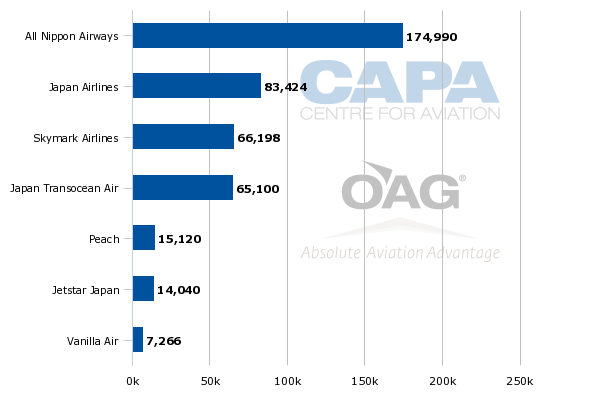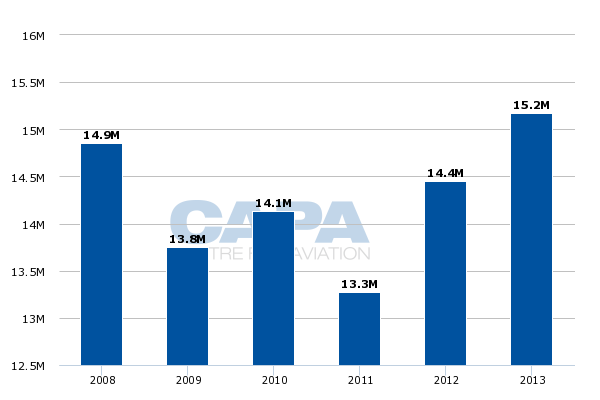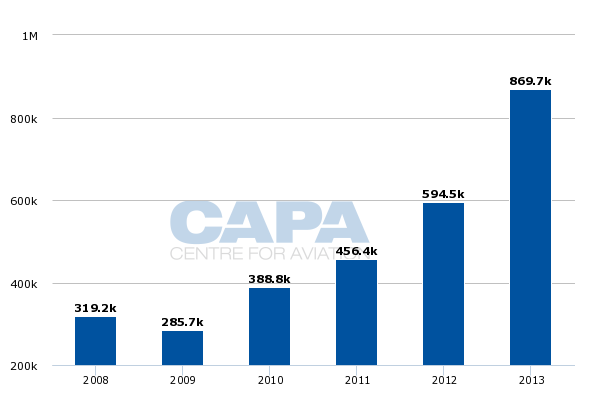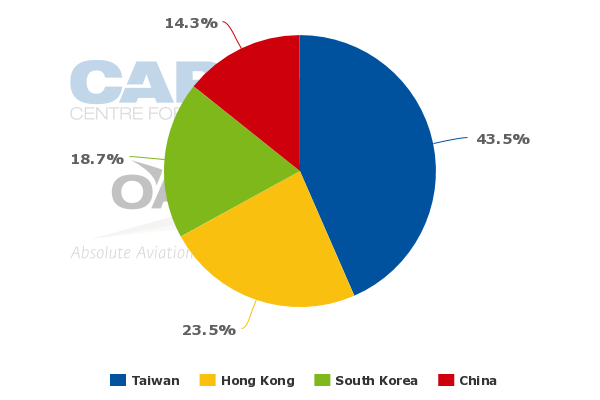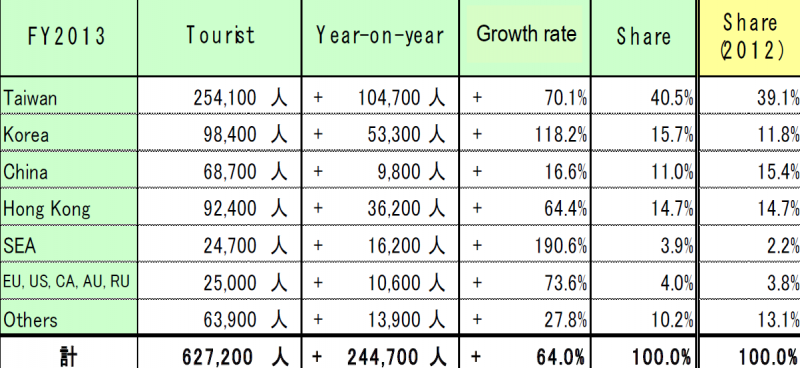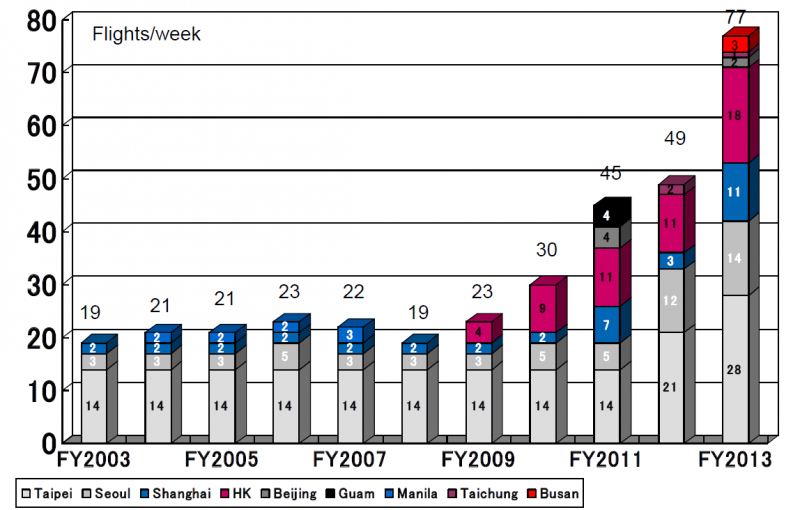Okinawa Naha Airport is poised for further rapid international growth as its network diversifies
Okinawa Naha Airport expects further rapid international growth as it begins to tap into the Southeast Asian market. Okinawa has seen a surge in international traffic, driven by new flights within North Asia, and is optimistic a new charter route to Singapore (operated by Jetstar Asia and SilkAir) will be upgraded to become its first scheduled service to Southeast Asia.
International passenger traffic at Okinawa Naha Airport has nearly tripled since 2011. A new international terminal which opened in Feb-2014 is already approaching capacity but plans are in the works for expansion.
For now the growth is being driven by inbound visitor traffic as Okinawa emerges as a popular tourist attraction. But Okinawa also has a potential role as a LCC transit airport, particularly after a second runway opens and further terminal expansion is pursued. Peach Aviation envisioned an Okinawa hub for Southeast Asian flights but requires a new low-cost terminal.
LCCs drive faster domestic growth at Okinawa
Okinawa Naha International Airport currently has nine scheduled international routes, all of which are to destinations within North Asia. The airport has traditionally been predominantly domestic and currently has 23 domestic routes operated by seven carriers, according to OAG data.
Domestic traffic has grown by nearly 20% since 2011, driven primarily by LCC expansion. All three of Japan's new generation LCCs - Peach Aviation, Jetstar Japan and Vanilla Air - now serve Okinawa. Combined the trio currently accounts for about 9% of domestic capacity at Naha, according to CAPA and OAG data.
Peach has about a 4% share of capacity in Okinawa's domestic market and three domestic routes (Fukuoka, Osaka and Ishigaki) compared to two for Jetstar Japan (Osaka and Tokyo) and one for Vanilla (Tokyo). Peach and Vanilla are both affiliated with All Nippon Airways (ANA) while Japan Airlines (JAL) owns a stake in Jetstar Japan.
ANA has a leading 41% share of domestic capacity at Okinawa while JAL has a 35% share when including the 15% share of its Naha-based subsidiary Japan Transocean Air.
Okinawa Naha Airport domestic capacity (seats) by carrier: 8-Sep-2014 to 14-Sep-2014
Okinawa handled 15.2 million domestic passengers in calendar 2013. This represented 5% growth over 2012 and 14% growth over 2011, when Peach and Jetstar Japan were launched.
Okinawa Naha Airport annual domestic passenger traffic: 2008 to 2013
Okinawa Naha Airport expects domestic passenger traffic to reach 16 million in the fiscal year ending 31-Mar-2015 (FY2014 based on the Japanese fiscal year). This would represent 5% growth compared to FY2013, 8% compared to FY2012 and 18% compared to FY2011.
Prior to FY2011, Okinawa domestic traffic had been on the decline for several years. Prior to the global financial crisis annual domestic traffic was almost 15 million.
Okinawa has achieved consistent rapid international passenger growth since 2009
Okinawa's international traffic, however, has grown steadily over the past five years. International passenger traffic grew by 46% in calendar 2013 to 870,000. This followed growth of 30% in 2012, 17% in 2011 and 36% in 2010.
Okinawa Naha Airport annual international passenger traffic: 2008 to 2013
Okinawa Naha Airport projects international passenger traffic will reach 1.2 million in FY2014, which would represent a 21% increase over FY2013 and 100% growth compared to FY2012. In FY2009 international passenger traffic at Okinawa was only 303,000.
Okinawa currently has scheduled international services from 12 foreign carriers, according to OAG data.
Peach is the only Japanese carrier with international services at Naha. It launched services from Okinawa to Taipei in Sep-2013. Peach and Korean Air subsidiary Jin Air are the only LCCs with international flights at Okinawa.
Okinawa Naha Airport international capacity (seats) by carrier: 8-Sep-2014 to 14-Sep-2014
| Rank | Airline | Total Seats | |
|---|---|---|---|
| 1 | CI | China Airlines | 7,842 |
| 2 | HX | Hong Kong Airlines | 6,776 |
| 3 | OZ | Asiana Airlines | 4,644 |
| 4 | MU | China Eastern Airlines | 2,866 |
| 5 | LJ | Jin Air | 2,646 |
| 6 | BR | EVA Air | 2,604 |
| 7 | MM | Peach | 2,520 |
| 8 | KA | Dragonair | 2,400 |
| 9 | GE | TransAsia Airways | 2,100 |
| 10 | AE | Mandarin Airlines | 1,872 |
| 11 | HO | Juneyao Airlines | 1,264 |
| 12 | GS | Tianjin Airlines | 768 |
| 13 | CA | Air China | 668 |
Okinawa Naha currently has scheduled non-stop flights to only four countries - China, Hong Kong, South Korea and Taiwan. Taiwan is the largest market and has seen a 53% increase in capacity over the past year, according to CAPA and OAG data.
Four Taiwanese carriers currently serve Okinawa.
Hong Kong passenger traffic has increased 75% while South Korea grew 28% and China by 93% (based on capacity data for the first week of Sep-2014 compared to the first week of Sep-2013). Hong Kong Airlines and Cathay Pacific regional subsidiary Dragonair both serve Naha while there are two South Korean carriers and four mainland Chinese carriers in the Okinawa market.
Okinawa Naha Airport international capacity (% of seats) by country: 8-Sep-2014 to 14-Sep-2014
Okinawa achieves rapid growth in tourist arrivals from North Asia
Taiwan accounted for just over 40% of the 627,000 foreign visitors reported by the Okinawa Prefecture in the fiscal year ending 31-Mar-2014 (FY2013 based on the Japanese fiscal year). Visitor traffic from Taiwan grew by 70% compared to FY2012 to 254,000.
Visitor numbers from Korea grew at an even faster clip, 118%, in FY2013 to about 98,000. Hong Kong visitor numbers grew by 64% to about 92,000 while China visitor numbers grew by a more modest 17% to about 69,000.
Okinawa foreign tourist numbers based on country of origin: FY2013 vs FY2012
Foreign tourist arrivals at Okinawa have grown seven fold since FY2006, when there were only 9,300 foreign visitors.
The number of international flights to Okinawa has increased from an average of only 19 per week in FY2008 to 77 in FY2013, according to government data.
Okinawa Naha Airport average number of international flights per week: FY2003 to FY2013
Okinawa starts to focus on developing the Southeast Asia market
Further growth from Okinawa's four main North Asian source markets is likely as Okinawa's popularity as an international tourist destination continues to grow. But the local government is also now focusing and investing heavily on opening up Southeast Asia as a new major source market.
Okinawa recorded 191% growth in foreign tourist arrivals from Southeast Asia in FY2013 but from a very small base. There were less than 25,000 foreign tourist arrivals from all of Southeast Asia in FY2013, accounting for less than 4% of the total foreign visitor pie.
(This figure is slightly misleading as it only counts tourists entering Japan at Okinawa. Some visitors from Southeast Asia reach Okinawa via larger Japanese gateways on the mainland. For Southeast Asian visitors this requires backtracking but there are no non-stop scheduled flights and direct connections via other North Asian cities can be limited or costly. Of the 24,700 Southeast Asian visitor arrivals in FY2013 some reached Okinawa Naha via North Asian hubs, primarily Taipei or Hong Kong, and some arrived in Okinawa via charters including from Bangkok and Singapore.)
After studying several potential Southeast Asian routes Okinawa decided to target Singapore, concluding that Okinawa is an appealing holiday destination to Singaporeans and that Singapore Changi Airport is an ideal hub for attracting visitors from throughout Southeast Asia, as well as India and Australia. The Okinawa government and Singapore signed in Mar-2014 a memorandum of understanding to strengthen tourism and trade flows between Okinawa and Singapore.
All Nippon Airways subsequently launched a six times per week freighter service from Okinawa to Singapore, enabling the two governments to meet the logistics and trade portion of their joint goal.
SilkAir and Jetstar launch charter flights on the Singapore-Okinawa route: airport business development initiatives
Okinawa Naha and Changi Airport have also been working jointly over the past six months to encourage several passenger airlines to establish a direct link. While none have agreed to launch scheduled flights, Singapore Airlines regional subsidiary SilkAir and Singapore-based LCC Jetstar Asia are mounting a series of charter flights to Naha over the next few months. (There have been charters previously between Okinawa and Singapore, including in FY2013, but this is the first time SilkAir or Jetstar Asia have flown to Naha.)
Okinawa Prefecture vice-governor Yoshihisa Kawakami said at a 10-Sep-2014 event in Singapore announcing the charter flights that the government is optimistic scheduled flights will be established within the next year. SilkAir and Jetstar executives said at the event they view the charters as an opportunity to test the market while continuing to evaluate the potential of offering regularly scheduled flights between Singapore and Okinawa.
SilkAir is operating a total of 12 flights to Naha over the next four months using 162-seat 737-800s. The first return flight operated on 9-Sep-2014 with high loads.
Okinawa Tourist Service and Jumbo Tours Okinawa are chartering the SilkAir flights, which enables the airline to test the market without any risk. While charters are typically sold only on a point to point basis by the travel agents underwriting the flights, for the Okinawa flights SilkAir is selling connections across the SilkAir and Singapore Airlines network. A seamless connection with through check-in is available just as if the flight were a scheduled service.
This the first time SilkAir has taken this kind of approach to charters. The carrier previously has only operated charters on an ad hoc basis and not as a trial for a potential scheduled route. SilkAir has closely studied the Naha market over the last several months with the Changi Airport Group and sees potential.
Jetstar Asia is operating two return flights to Naha in late Nov-2014 with all the seats being sold by Okinawa Tourist Service. Despite the very small number of flights Jetstar believes it is sufficient to help test the market out to determine if a scheduled flight can be launched. "We are being cautious but in the long-run are optimistic Okinawa-Singapore traffic can sustain itself," said Jetstar Asia acting head of commercial Francis Loi.
Jetstar Asia is using 180-seat A320s on the route but payload restrictions limit the number of passengers to about 165. Singapore-Naha becomes the longest route operated by both Jetstar Asia and SilkAir.
But the flight, which is about five hours, is only slightly longer than Singapore-Hangzhou, which is operated on a regular scheduled basis by both carriers. (Jetstar Asia also has payload restrictions on Hangzhou but SilkAir, which configures its A320s and 737-800s with a less dense two-class configuration, does not have any restrictions on Hangzhou or Okinawa.)
New Okinawa route could give Jetstar Asia opportunity to work more closely with Jetstar Japan
The 9-Sep-2014 flight to Okinawa marked the first time SilkAir has flown to Japan. Jetstar Asia began serving Japan in 2011 when it launched services to Osaka Kansai via Taipei. It added service to Osaka via Manila in 2012 and in Jun-2014 began serving Fukuoka via Bangkok.
The Jetstar brand also has a strong presence in the Japanese domestic market through Jetstar Japan, which has quickly grown since its 2011 launch and now operates as many A320s (18 aircraft) as its more mature Singapore-based sister carrier. Jetstar Japan has served Okinawa since 2012 and currently operates up to seven daily flights to Naha, including up to four from Tokyo Narita and three from Tokyo Osaka.
If Jetstar Asia takes the plunge and offers non-stop scheduled flights from Singapore to Okinawa it could open up new one-stop connections to Tokyo Narita as well as potentially other Japanese cities if Jetstar Japan expands its Okinawa domestic network. Jetstar Asia currently works with Jetstar Japan in Fukuoka and Osaka but the number of Singapore passengers that transits between the two carriers is very small.
The Jetstar Asia to Jetstar Japan connections at Fukuoka and Osaka work better for passengers originating in Bangkok, Manila or Taipei as these markets are linked non-stop to Japan. Okinawa could potentially provide a better connection opportunity for the two Jetstar affiliates as it is the only Japanese destination that is within non-stop narrowbody range of Singapore.
Peach Aviation's potential Okinawa base unlikely in the short-term
Peach also has been looking at launching services from Okinawa to Southeast Asia as part of a potential Okinawa hub that would provide connections to Southeast Asia from other parts of Japan. As CAPA analysed in Mar-2013, the Peach hub plan for Okinawa envisions services from Naha to Bangkok, Hanoi and Ho Chi Minh in Southeast Asia as well as Hong Kong, Busan, Seoul and Taipei in North Asia. (Singapore and Kuala Lumpur are not part of this plan as Peach prefers to stick to routes of up to four hours.)
See related report: Low-cost airline Peach boldly pursues Japan-Southeast Asia one-stop market using new Okinawa base
But so far Peach has only launched one international route at Naha, Taipei. Naha Airport Building Company president Yoritaka Hanashico told CAPA that Peach has discussed establishing a hub at Naha but requires a new low-cost terminal. The Naha airport is interested in potentially building a low-cost terminal but currently does not have the space.
The potential site for the low-cost terminal is south of the two existing terminals and is currently being used by the Japan Self Defence Force. The airport is interested in converting this area into a terminal dedicated for LCCs but the local government, which owns the Naha Airport, first needs to get authorisation to take over the space.
Peach and Vanilla are now operating from a cargo terminal which has been renovated by ANA for passenger use. An immigration and customs facility was added last year to support the new Taipei flights. But the cargo terminal, which is not owned by Naha Airport, is too small to support a potential hub.
Peach could use the main terminal, which is owned by Naha Airport and used by all carriers serving Naha except Peach and Vanilla. But Peach generally prefers an alternative solution. For example it uses the more simplified Terminal 2 at its main base, Osaka Kansai.
Okinawa Naha plans further terminal and runway expansion
Mr Hanashico said Naha Airport is now looking to expand the new international terminal, which opened in Feb-2014. The new terminal has only two gates and is already approaching its designed capacity of 1.5 million passengers per annum.
There is space available for construction between the international and domestic terminals which could increase the capacity of the international terminal to between 3.5 million and 4 million passengers per annum. A decision on the expansion is expected at the end of the current fiscal year in Mar-2015.
Some of the unused space in-between the two current terminals will also likely be used to slightly expand the capacity of the domestic terminal. The domestic terminal is already operating slightly above its designed capacity of 15 million passengers per annum.
As there is limited space to expand the domestic and international terminals, Naha Airport is starting to look at a longer-term solution. The long-term solution would involve the construction of an entirely new terminal complex alongside the planned second runway, which is expected to be completed in 2020. This would be an extremely expensive project requiring significant landfill but necessary given the current limitations with the existing space.
Okinawa has big ambitions and bright outlook
A larger airport will ultimately be required given Okinawa's target for attracting 10 million annual tourists by FY2021 compared to 6 million in FY2012. This target includes an increase in foreign tourists from 380,000 in FY2012 to 2 million in FY2021.
This is not overly ambitious given Okinawa's growing popularity as a tourist destination and the overall growth that is anticipated/hoped for across the Japanese tourism sector.
Japan has a national goal of increasing international visitor numbers from 10 million in 2013 to 20 million in 2020. Okinawa accounting for 10% of total visitors to Japan seems realistic, particularly given that Southeast Asia is on Okinawa's doorstep and is the fastest growing source market. Japan recorded 48% growth in visitor traffic from Southeast Asia in 2013 to about 1 million, including 190,000 from Singapore.
A larger airport at Naha will also be required for Okinawa to assume a potential hub role. For now the focus is primarily on growing inbound visitor numbers, particularly from Southeast Asia. But over time Okinawa could become a hub airport (as envisioned by Peach) assuming the right infrastructure is put in place.
Okinawa has a bright outlook, thanks to its tourist attractions and favourable geography. With the right airport investments and strategy it could become a leading international destination as well as a hub.
